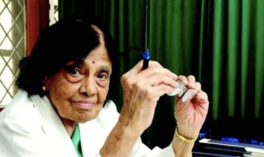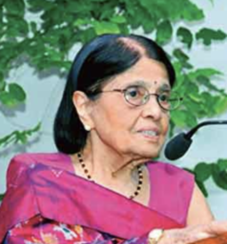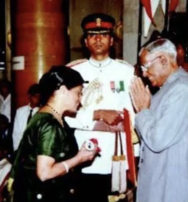
Dr. Sivaramakrishna Iyer Padmavati was born in 1917 in Myanmar (previously known as Burma). She was born to a barrister father, which is a type of lawyer, and had multiple siblings. A studious child interested in medicine, she excelled in school and attended Rangoon University, where she earned the first medical degree given to a woman from that school.
In 1941, when Dr. Padmavati was 24 years old, Burma was invaded by Japan and she and her family were forced to leave. The women in the family fled to Coimbatore, India, while the men stayed. There, they reunited with their brothers and father after WWII was over.
In 1949, Dr. Padmavati moved to England to accept a position at the Royal College of Physicians in London, then Edinburgh as a fellow. There, her interest turned towards cardiology, a field that was barely developed during the time and she continued her studies in Sweden. In Sweden, she worked with and learned from cardiologists who were developing the echocardiogram, a tool used in cardiology that was based on the equipment used by deep sea divers. According to Dr. Padmavati, “I pursued cardiology because there were very few courses available to women when I went to college, unlike today.”

After leaving Sweden, Dr. Padamavti soon received a fellowship in the United States. She worked at Johns Hopkins University in the Pediatrics department. While in the U.S., she was employed under Dr. Helen Taussig, another pioneer in cardiology, studying and performing surgeries on babies born with heart defects. After that, Dr. Padmavati moved on to Harvard Medical School and studied under Dr. Paul Dudley White, yet another trailblazer in the still-small area of cardiology.
With newly-gained experience in cardiology, Dr. Padmavati decided to move back home to India in 1952. There, she expanded Indian knowledge of cardiology and became a professor and lecturer at Lady Hardinge Medical College, an all-girls college in Delhi. She also established India’s first cardiac clinic and catheter lab with help from the Rockefeller Foundation to pave the way for future cardiologists.

Throughout her entire career, Dr. Padmavati consistently conducted clinical research and published over 300 scientific papers concerning the prevention of cardiovascular disease and medicine. She also educated the Indian public about cardiovascular risk factors, including junk food and smoking. She was instrumental in demanding more government intervention in the people’s fast-growing consumption of fast food and in promoting the dangers of cigarettes and smoking in India.
Dr. Padmavati went on to establish cardiology departments and labs at many universities, including Maulana Azad Medical College in New Delhi, where she was the principal and director, GB Pant Hospital. In 1962, Dr. Padmavati became the founding director of the AIHF, or the All India Heart Foundation, which was vital in spreading knowledge about preventive medicines for cardiovascular disease throughout India. In 1981, she founded the National Heart Institution, in order to accomplish a similar goal of spreading awareness about cardiology. Throughout her career, she believed in staying up to date on the latest practices in cardiology and learning as much as she could about the newest developments.
In recognition of her contributions to cardiology and to India itself, Dr. Padmavati was awarded the Padma Bhushan and the Padma Vibhushan, the third and second highest honors, respectively, able to be bestowed on an Indian civilian. The Padma Bhushan is awarded for “distinguished service of a high order” and the Padma Vibhushan for “exceptional and distinguished service”. She was also elected to be a fellow in the National Academy of Medical Sciences.
Still alive and unmarried at 102 as of May 2020, Dr. Padmavati remains healthy due to her nutritious eating and her habit of swimming and taking walks every day. Of this habit, she says, “Things were different earlier. Physical activity and a healthy diet were the norms. Now, times have changed.” Although retired, she still sometimes sees patients at home or at hospitals and keeps up with the latest medical journals and world news.
Why Did I Choose to Research Dr. Padmavati Iyer?
I am interested in learning more about Indian women’s contributions to the world, which led me to searching the field of medicine for prominent women. There, I found Dr. Padmavati and her incredible journey in being a pioneer in cardiology. What especially interested me was the fact that she studied in and learned from so many different places, which showed me how dedicated and determined she was to simply learning as much as she could in a time when a woman was unlikely to get an education, much less an extensive one like hers.
Works Cited
Chugh, P. (2018, November 5). A Woman of Many Firsts: Meet India's First and Oldest Cardiologist! Retrieved May 3, 2020, from https://www.thebetterindia.com/143768/indias-first-oldest-cardiologist-sivaramakrishna-iyer-padmavati/
European Society of Cardiology. (n.d.). A Centenarian Fellow; Sivaramakrishna Iyer Padmavati, FESC. Retrieved April 26, 2020, from https://www.escardio.org/The-ESC/Who-we-are/Fellowship/dr-sivaramakrishna-iyer-padmavati-fesc
Morrison, S. (2018, July 12). Undercooked: An Expensive Push to Save Lives and Protect the Planet Falls Short. Retrieved May 3, 2020, from https://www.propublica.org/article/cookstoves-push-to-protect-the-planet-falls-short
Nair, N. (2017, July 20). Doctor with a big heart. Open. Retrieved from https://openthemagazine.com/shorts/doctor-with-a-big-heart/
Rao, R. (n.d.). Sivaramakrishna Iyer Padmavati. Retrieved May 3, 2020, from https://www.womenofhopkins.com/padmavati
Sanghvi, C. (2018, October 11). India's first and oldest cardiologist. Retrieved May 3, 2020, from https://www.thinkright.me/en/live-right/indias-first-and-oldest-cardiologist/
This article was published on 9/28/20